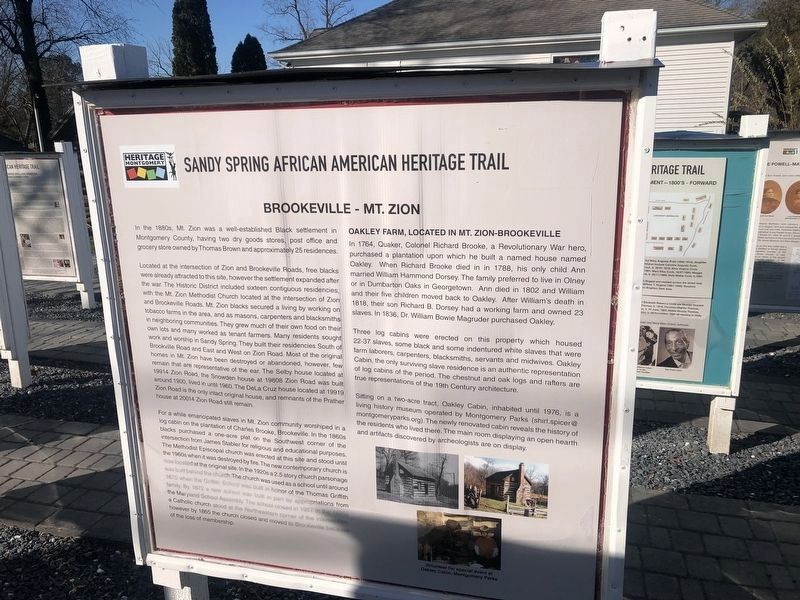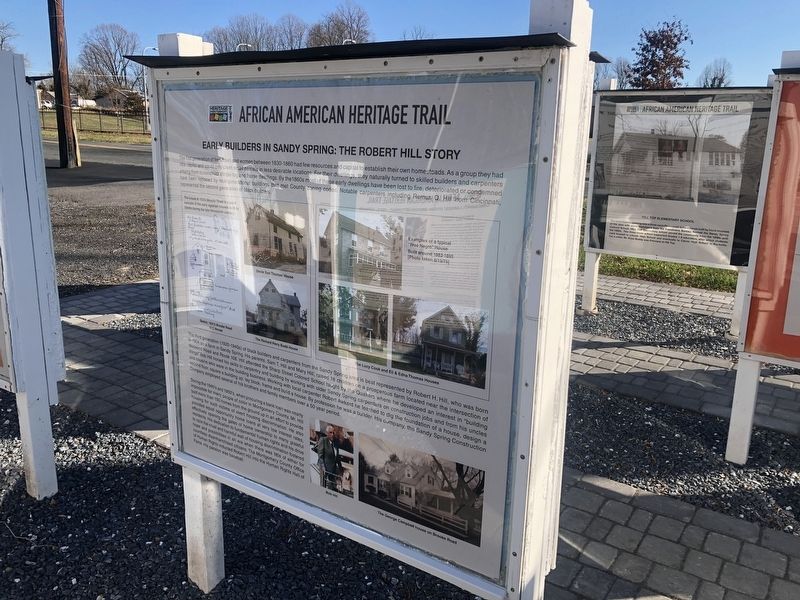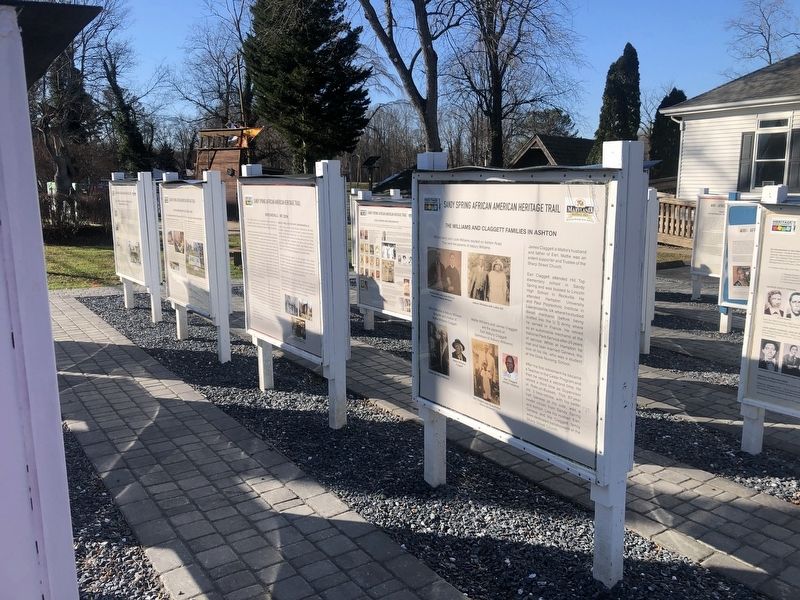Sandy Spring in Montgomery County, Maryland — The American Northeast (Mid-Atlantic)
Brookeville - Mt. Zion / Early Builders in Sandy Spring: The Robert Hill Story
Sandy Spring African American Heritage Trail
— [Sandy Spring Slave Museum & African Art Gallery] —

Photographed By Devry Becker Jones (CC0), December 12, 2021
1. Brookeville - Mt. Zion side of the marker
Brookeville - Mt. Zion
In the 1880s, Mt. Zion was a well-established Black settlement in Montgomery County, having two dry goods stores, post office and grocery store owned by Thomas Brown and approximately 25 residences.
Located at the intersection of Zion and Brookeville Roads, free blacks were already attracted to this site, however the settlement expanded after the war. The Historic District included sixteen contiguous residencies, with the Mt. Zion Methodist Church located at the intersection of Zion and Brookeville Roads. Mt. Zion blacks secured a living by working on tobacco farms in the area, and as-masons, carpenters and blacksmiths in neighboring communities. They grew much of their own food on their own lots and many worked as tenant farmers. Many residents sought work and worship in Sandy Spring. They built their residencies South of Brookeville Road and East and West on Zion Road. Most of the original homes in Mt. Zion have been destroyed or abandoned, however, few remain that are representative of the ear. The Selby house located at 19914 Zion Road, the Snowden house at 19808 Zion Road was built around 1900, lived in until 1960. The DeLa Cruz house located at 19919 Zion Road is the only intact original house, and remnants of the Prather house at 20014 Zion Road still remain.
For a while emancipated slaves in Mt. Zion community worshiped in a log cabin on the plantation of Charles Brooke, Brookeville. In the 1860s blacks purchased a one-acre plat on the Southwest corner of the intersection from James Stabler for religious and educational purposes. The Methodist Episcopal church was erected at this site and stood until the 1960s when it was destroyed by fire. The new contemporary church is now located at the original site. In the 1920s a 2.5 story church parsonage was built behind the church. The church was used as a school until around 1870 when the Griffith School was built in honor of the Thomas Griffith family. By 1872 a new school was built in part by appropriations from the Maryland School Assembly. The school closed in 1957. In the 1860s a Catholic church stood at the Northeastern corner of the intersection however by 1865 the church closed and moved to Brookeville because of the loss of membership.
Oakley Farm, Located in Mt. Zion-Brookeville
In 1764, Quaker, Colonel Richard Brooke, a Revolutionary War hero, purchased a plantation upon which he built a named house named Oakley. When Richard Brooke died in in 1788, his only child Ann married William Hammond Dorsey. The family preferred to live in Olney or in Dumbarton Oaks in Georgetown. Ann died in 1802 and William and their five children

Photographed By Devry Becker Jones (CC0), December 12, 2021
2. Early Builders in Sandy Spring: The Robert Hill Story side of the marker
Three log cabins were erected on this property which housed 22-37 slaves, some black and some indentured white slaves that were farm laborers, carpenters, blacksmiths, servants and midwives. Oakley Cabin, the only surviving slave residence is an authentic representation of log cabins of the period. The chestnut and oak logs and rafters are true representations of the 19th Century architecture.
Sitting on a two-acre tract, Oakley Cabin, inhabited until 1976, is a living history museum operated by Montgomery Parks ([email protected]). The newly renovated cabin reveals the history of the residents who lived there. The main room displaying an open hearth and artifacts discovered by archaeologists are on display.
Early Builders in Sandy Spring: The Robert Hill Story
The first generation of freedmen and women between 1830-1860 had few resources and capital to establish their own homesteads. As a group they had little capital and could only claim small parcels in less desirable locations. For their dwellings, they naturally turned to skilled builders and carpenters among them to construct simple log and frame dwellings. By the 1860s

Photographed By Devry Becker Jones (CC0), December 12, 2021
3. Brookeville - Mt. Zion side of the marker
The third generation (1920-1940s) of black builders and carpenters from the Sandy Spring area is best represented by Robert H. Hill, who was born in 1904 on a farm in Sandy Spring. His parents, Sam T. Hill and Mary Hill, raised 18 children on a prosperous farm located near the intersection of Norwood Road and Route 108. Hill attended the Sharp Street Colored School taught by the Quakers where he developed an interest in "building things." Bob Hill honed his skills in carpentry and building by working with older Sandy Spring carpenters on construction jobs from his uncles and cousins who were in the building business. Working with local carpenter Robert Awkard he learned to dig the foundation of a house, design a second floor, square a building up, lay block, frame and build a house. By profession he was a builder. His company, the Sandy Spring Construction Company employed several of his brothers and family members over a 50 year period.
During the 1940's and 1950's, when procuring a bank loan was nearly impossible for many people of color in Montgomery County, Mr. Hill built more than 150
![]Early Builders in Sandy Spring: The Robert Hill Story side of the marker. Click for full size. ]Early Builders in Sandy Spring: The Robert Hill Story side of the marker image. Click for full size.](Photos6/627/Photo627978.jpg?12142021115400AM)
Photographed By Devry Becker Jones (CC0), December 12, 2021
4. ]Early Builders in Sandy Spring: The Robert Hill Story side of the marker
[Caption:]
The house at 18313 Brooke Road is a good example of the early agrarian houses built by blacks during the late Nineteenth century.
Erected by Sandy Spring Slave Museum & African Art Gallery.
Topics. This historical marker is listed in these topic lists: African Americans • Agriculture • Architecture • Churches & Religion • Colonial Era • Industry & Commerce • Settlements & Settlers. A significant historical year for this entry is 1900.
Location. 39° 9.579′ N, 77° 1.972′ W. Marker is in Sandy Spring, Maryland, in Montgomery County. Marker is on Brooke Road, 0.1 miles west of Chandlee Mill Road, on the right when traveling west. Touch for map. Marker is at or near this postal address: 18524 Brooke Rd, Sandy Spring MD 20860, United States of America. Touch for directions.
Other nearby markers. At least 8 other markers are within walking distance of this marker. The Powell-Matthews-Cook and Brooks Families in Sandy Spring / Spencerville (here, next to this marker); Mysteries of the Hopkins House / Free Black Slaves Settled the Norbeck Community (here, next to this marker); The Williams and Claggett Families in Ashton / Lineage of Greenberry Howard Family (here, next to this marker); Enoch George Howard and John Henry Howard / The Dorsey, Williams and Johnson Connections (here, next to this marker); Cincinnati, Largest African American Settlement / Journey from Alloway to Sandy Spring (here, next to this marker); Sadie Matthews Budd and Family / The Bowens, Mitchells and Jacksons of Ashton and Baltimore, MD (here, next to this marker); Woodlawn Manor Cultural Park / The Hill's of Holly Grove / Lineage of the Hill Family (here, next to this marker); Charles Gilbert Thomas, Sr. / William and Evan Budd Homestead / Sandy Spring School / Ross J. Boddy (here, next to this marker). Touch for a list and map of all markers in Sandy Spring.
Credits. This page was last revised on January 24, 2022. It was originally submitted on December 14, 2021, by Devry Becker Jones of Washington, District of Columbia. This page has been viewed 549 times since then and 208 times this year. Photos: 1, 2, 3, 4. submitted on December 14, 2021, by Devry Becker Jones of Washington, District of Columbia.